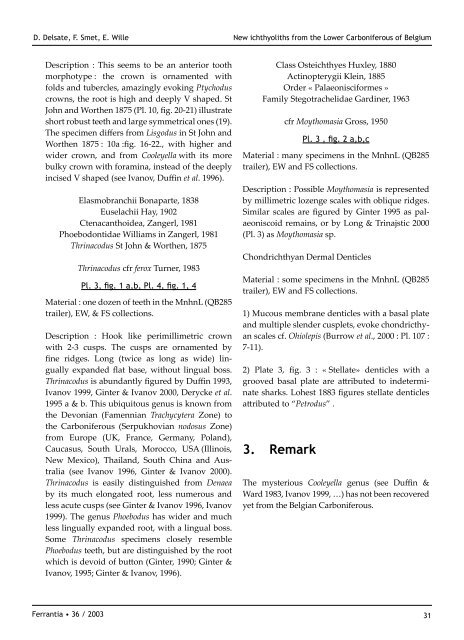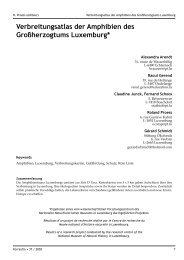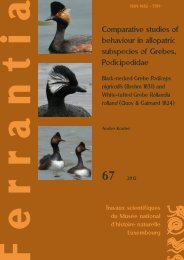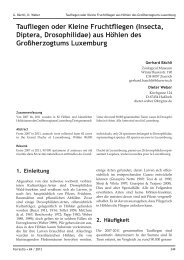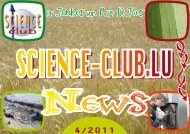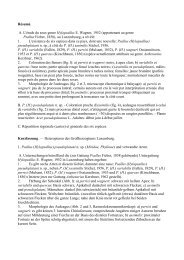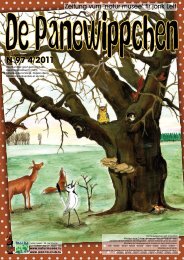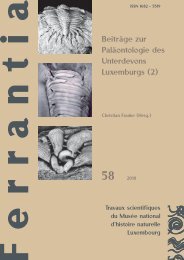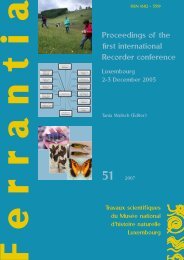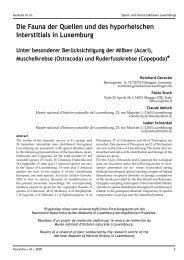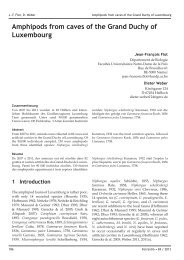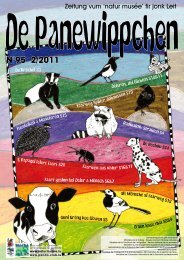Publi.complète - Musée national d'histoire naturelle
Publi.complète - Musée national d'histoire naturelle
Publi.complète - Musée national d'histoire naturelle
You also want an ePaper? Increase the reach of your titles
YUMPU automatically turns print PDFs into web optimized ePapers that Google loves.
D. Delsate, F. Smet, E. Wille New ichthyoliths from the Lower Carboniferous of Belgium<br />
Description : This seems to be an anterior tooth<br />
morphotype : the crown is ornamented with<br />
folds and tubercles, amazingly evoking Ptychodus<br />
crowns, the root is high and deeply V shaped. St<br />
John and Worthen 1875 (Pl. 10, fig. 20-21) illustrate<br />
short robust teeth and large symmetrical ones (19).<br />
The specimen differs from Lisgodus in St John and<br />
Worthen 1875 : 10a :fig. 16-22., with higher and<br />
wider crown, and from Cooleyella with its more<br />
bulky crown with foramina, instead of the deeply<br />
incised V shaped (see Ivanov, Duffin et al. 1996).<br />
Elasmobranchii Bonaparte, 1838<br />
Euselachii Hay, 1902<br />
Ctenacanthoidea, Zangerl, 1981<br />
Phoebodontidae Williams in Zangerl, 1981<br />
Thrinacodus St John & Worthen, 1875<br />
Ferrantia • 36 / 2003<br />
Thrinacodus cfr ferox Turner, 1983<br />
Pl. 3, fig. 1 a,b, Pl. 4, fig. 1, 4<br />
Material : one dozen of teeth in the MnhnL (QB285<br />
trailer), EW, & FS collections.<br />
Description : Hook like perimillimetric crown<br />
with 2-3 cusps. The cusps are ornamented by<br />
fine ridges. Long (twice as long as wide) lingually<br />
expanded flat base, without lingual boss.<br />
Thrinacodus is abundantly figured by Duffin 1993,<br />
Ivanov 1999, Ginter & Ivanov 2000, Derycke et al.<br />
1995 a & b. This ubiquitous genus is known from<br />
the Devonian (Famennian Trachycytera Zone) to<br />
the Carboniferous (Serpukhovian nodosus Zone)<br />
from Europe (UK, France, Germany, Poland),<br />
Caucasus, South Urals, Morocco, USA (Illinois,<br />
New Mexico), Thailand, South China and Australia<br />
(see Ivanov 1996, Ginter & Ivanov 2000).<br />
Thrinacodus is easily distinguished from Denaea<br />
by its much elongated root, less numerous and<br />
less acute cusps (see Ginter & Ivanov 1996, Ivanov<br />
1999). The genus Phoebodus has wider and much<br />
less lingually expanded root, with a lingual boss.<br />
Some Thrinacodus specimens closely resemble<br />
Phoebodus teeth, but are distinguished by the root<br />
which is devoid of buon (Ginter, 1990; Ginter &<br />
Ivanov, 1995; Ginter & Ivanov, 1996).<br />
Class Osteichthyes Huxley, 1880<br />
Actinopterygii Klein, 1885<br />
Order « Palaeonisciformes »<br />
Family Stegotrachelidae Gardiner, 1963<br />
cfr Moythomasia Gross, 1950<br />
Pl. 3 , fig. 2 a,b,c<br />
Material : many specimens in the MnhnL (QB285<br />
trailer), EW and FS collections.<br />
Description : Possible Moythomasia is represented<br />
by millimetric lozenge scales with oblique ridges.<br />
Similar scales are figured by Ginter 1995 as palaeoniscoid<br />
remains, or by Long & Trinajstic 2000<br />
(Pl. 3) as Moythomasia sp.<br />
Chondrichthyan Dermal Denticles<br />
Material : some specimens in the MnhnL (QB285<br />
trailer), EW and FS collections.<br />
1) Mucous membrane denticles with a basal plate<br />
and multiple slender cusplets, evoke chondricthyan<br />
scales cf. Ohiolepis (Burrow et al., 2000 : Pl. 107 :<br />
7-11).<br />
2) Plate 3, fig. 3 : « Stellate» denticles with a<br />
grooved basal plate are aributed to indeterminate<br />
sharks. Lohest 1883 figures stellate denticles<br />
aributed to “Petrodus” .<br />
3. Remark<br />
The mysterious Cooleyella genus (see Duffin &<br />
Ward 1983, Ivanov 1999, …) has not been recovered<br />
yet from the Belgian Carboniferous.<br />
31


